2014 FIAT 500L LIVING inflation pressure
[x] Cancel search: inflation pressurePage 184 of 420
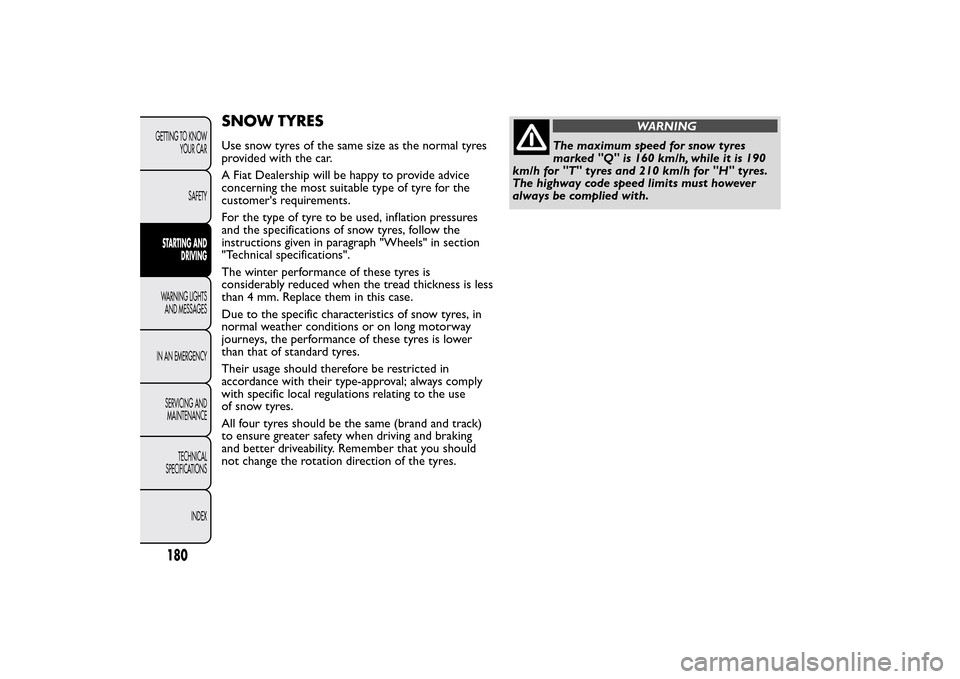
SNOW TYRESUse snow tyres of the same size as the normal tyres
provided with the car.
A Fiat Dealership will be happy to provide advice
concerning the most suitable type of tyre for the
customer's requirements.
For the type of tyre to be used, inflation pressures
and the specifications of snow tyres, follow the
instructions given in paragraph "Wheels" in section
"Technical specifications".
The winter performance of these tyres is
considerably reduced when the tread thickness is less
than 4 mm. Replace them in this case.
Due to the specific characteristics of snow tyres, in
normal weather conditions or on long motorway
journeys, the performance of these tyres is lower
than that of standard tyres.
Their usage should therefore be restricted in
accordance with their type-approval; always comply
with specific local regulations relating to the use
of snow tyres.
All four tyres should be the same (brand and track)
to ensure greater safety when driving and braking
and better driveability. Remember that you should
not change the rotation direction of the tyres.
WARNING
The maximum speed for snow tyres
marked "Q" is 160 km/h, while it is 190
km/h for "T" tyres and 210 km/h for "H" tyres.
The highway code speed limits must however
always be complied with.
180GETTING TO KNOW
YOUR CAR
SAFETYSTARTING AND
DRIVINGWARNING LIGHTS
AND MESSAGES
IN AN EMERGENCY
SERVICING AND
MAINTENANCE
TECHNICAL
SPECIFICATIONS
INDEX
Page 209 of 420
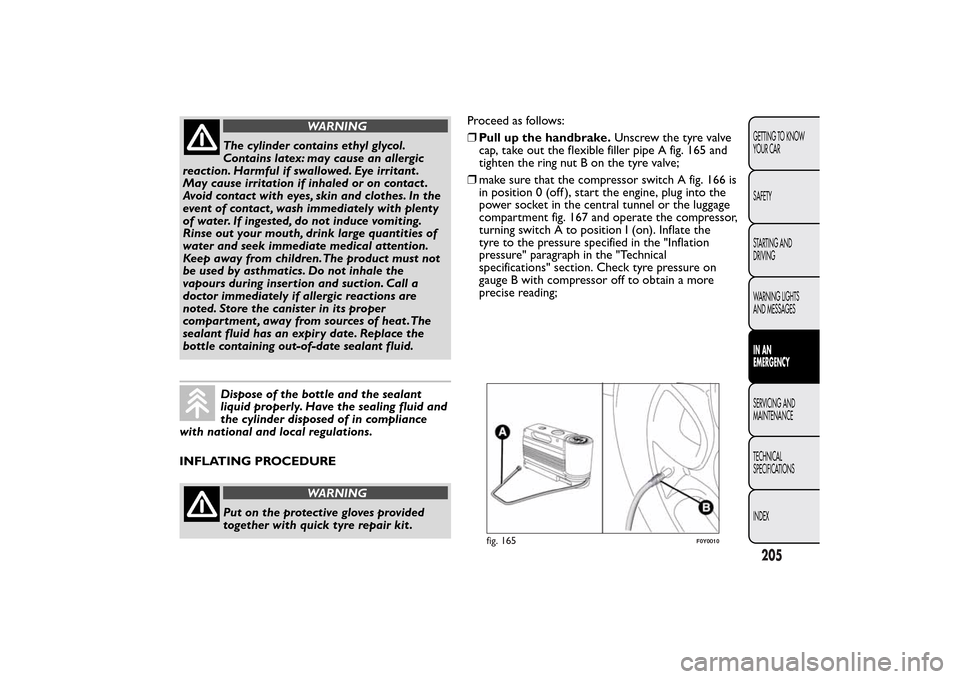
WARNING
The cylinder contains ethyl glycol.
Contains latex: may cause an allergic
reaction. Harmful if swallowed. Eye irritant .
May cause irritation if inhaled or on contact .
Avoid contact with eyes, skin and clothes. In the
event of contact , wash immediately with plenty
of water. If ingested, do not induce vomiting.
Rinse out your mouth, drink large quantities of
water and seek immediate medical attention.
Keep away from children.The product must not
be used by asthmatics. Do not inhale the
vapours during insertion and suction. Call a
doctor immediately if allergic reactions are
noted. Store the canister in its proper
compartment , away from sources of heat .The
sealant fluid has an expiry date. Replace the
bottle containing out-of-date sealant fluid.Dispose of the bottle and the sealant
liquid properly. Have the sealing fluid and
the cylinder disposed of in compliance
with national and local regulations.
INFLATING PROCEDURE
WARNING
Put on the protective gloves provided
together with quick tyre repair kit .Proceed as follows:
❒Pull up the handbrake.Unscrew the tyre valve
cap, take out the flexible filler pipe A fig. 165 and
tighten the ring nut B on the tyre valve;
❒make sure that the compressor switch A fig. 166 is
in position 0 (off ), start the engine, plug into the
power socket in the central tunnel or the luggage
compartment fig. 167 and operate the compressor,
turning switch A to position I (on). Inflate the
tyre to the pressure specified in the "Inflation
pressure" paragraph in the "Technical
specifications" section. Check tyre pressure on
gauge B with compressor off to obtain a more
precise reading;
fig. 165
F0Y0010
205GETTING TO KNOW
YOUR CAR
SAFETY
STARTING AND
DRIVING
WARNING LIGHTS
AND MESSAGESIN AN
EMERGENCYSERVICING AND
MAINTENANCE
TECHNICAL
SPECIFICATIONS
INDEX
Page 210 of 420
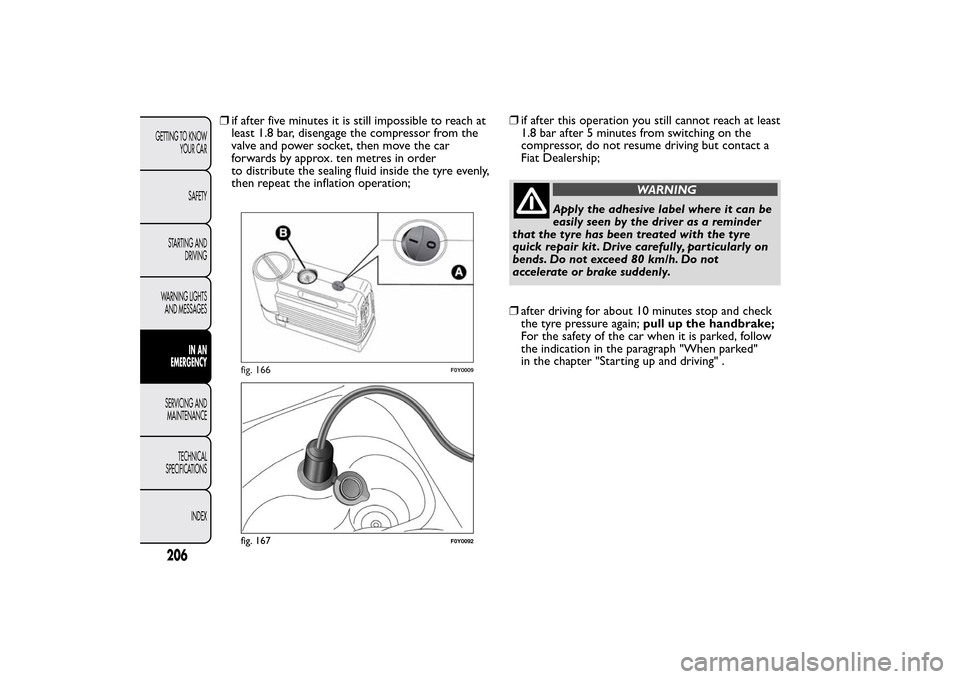
❒if after five minutes it is still impossible to reach at
least 1.8 bar, disengage the compressor from the
valve and power socket, then move the car
forwards by approx. ten metres in order
to distribute the sealing fluid inside the tyre evenly,
then repeat the inflation operation;❒if after this operation you still cannot reach at least
1.8 bar after 5 minutes from switching on the
compressor, do not resume driving but contact a
Fiat Dealership;
WARNING
Apply the adhesive label where it can be
easily seen by the driver as a reminder
that the tyre has been treated with the tyre
quick repair kit . Drive carefully, particularly on
bends. Do not exceed 80 km/h. Do not
accelerate or brake suddenly.
❒after driving for about 10 minutes stop and check
the tyre pressure again;pull up the handbrake;
For the safety of the car when it is parked, follow
the indication in the paragraph "When parked"
in the chapter "Starting up and driving" .
fig. 166
F0Y0009
fig. 167
F0Y0092
206GETTING TO KNOW
YOUR CAR
SAFETY
STARTING AND
DRIVING
WARNING LIGHTS
AND MESSAGES
IN AN
EMERGENCY
SERVICING AND
MAINTENANCE
TECHNICAL
SPECIFICATIONS
INDEX
Page 248 of 420
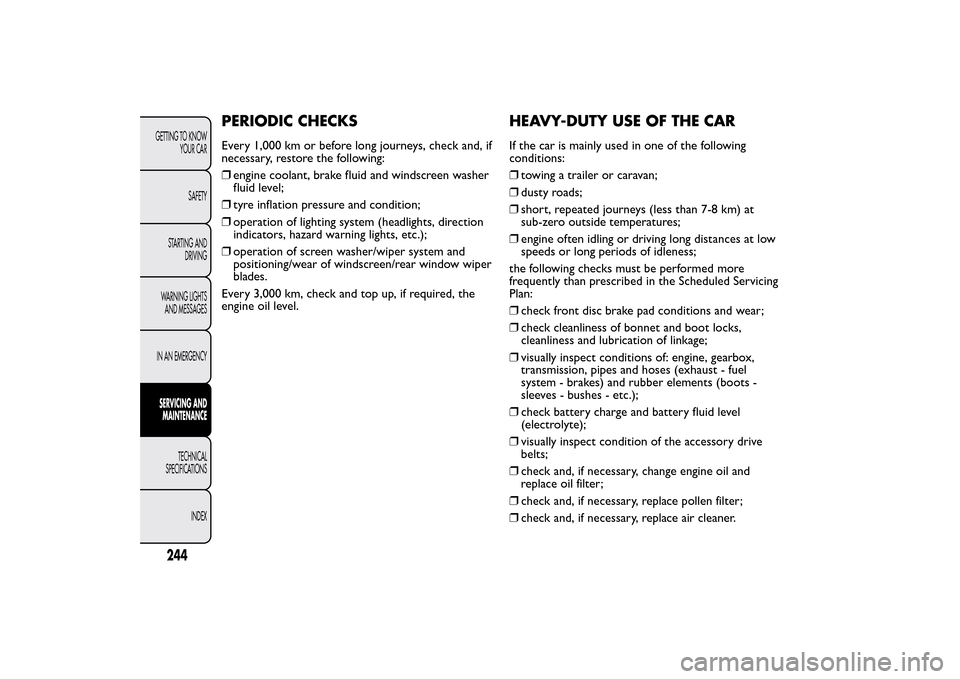
PERIODIC CHECKSEvery 1,000 km or before long journeys, check and, if
necessary, restore the following:
❒engine coolant, brake fluid and windscreen washer
fluid level;
❒tyre inflation pressure and condition;
❒operation of lighting system (headlights, direction
indicators, hazard warning lights, etc.);
❒operation of screen washer/wiper system and
positioning/wear of windscreen/rear window wiper
blades.
Every 3,000 km, check and top up, if required, the
engine oil level.
HEAVY-DUTY USE OF THE CARIf the car is mainly used in one of the following
conditions:
❒towing a trailer or caravan;
❒dusty roads;
❒short, repeated journeys (less than 7-8 km) at
sub-zero outside temperatures;
❒engine often idling or driving long distances at low
speeds or long periods of idleness;
the following checks must be performed more
frequently than prescribed in the Scheduled Servicing
Plan:
❒check front disc brake pad conditions and wear;
❒check cleanliness of bonnet and boot locks,
cleanliness and lubrication of linkage;
❒visually inspect conditions of: engine, gearbox,
transmission, pipes and hoses (exhaust - fuel
system - brakes) and rubber elements (boots -
sleeves - bushes - etc.);
❒check battery charge and battery fluid level
(electrolyte);
❒visually inspect condition of the accessory drive
belts;
❒check and, if necessary, change engine oil and
replace oil filter;
❒check and, if necessary, replace pollen filter;
❒check and, if necessary, replace air cleaner.
244GETTING TO KNOW
YOUR CAR
SAFETY
STARTING AND
DRIVING
WARNING LIGHTS
AND MESSAGES
IN AN EMERGENCYSERVICING AND
MAINTENANCE
TECHNICAL
SPECIFICATIONS
INDEX
Page 259 of 420
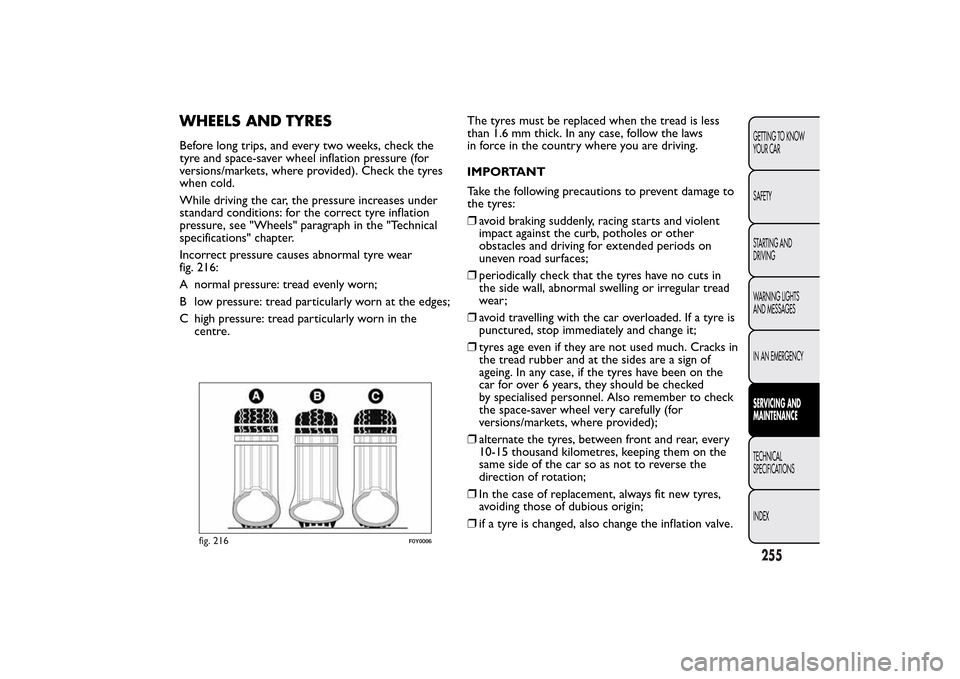
WHEELS AND TYRESBefore long trips, and every two weeks, check the
tyre and space-saver wheel inflation pressure (for
versions/markets, where provided). Check the tyres
when cold.
While driving the car, the pressure increases under
standard conditions: for the correct tyre inflation
pressure, see "Wheels" paragraph in the "Technical
specifications" chapter.
Incorrect pressure causes abnormal tyre wear
fig. 216:
A normal pressure: tread evenly worn;
B low pressure: tread particularly worn at the edges;
C high pressure: tread particularly worn in the
centre.The tyres must be replaced when the tread is less
than 1.6 mm thick. In any case, follow the laws
in force in the country where you are driving.
IMPORTANT
Take the following precautions to prevent damage to
the tyres:
❒avoid braking suddenly, racing starts and violent
impact against the curb, potholes or other
obstacles and driving for extended periods on
uneven road surfaces;
❒periodically check that the tyres have no cuts in
the side wall, abnormal swelling or irregular tread
wear;
❒avoid travelling with the car overloaded. If a tyre is
punctured, stop immediately and change it;
❒tyres age even if they are not used much. Cracks in
the tread rubber and at the sides are a sign of
ageing. In any case, if the tyres have been on the
car for over 6 years, they should be checked
by specialised personnel. Also remember to check
the space-saver wheel very carefully (for
versions/markets, where provided);
❒alternate the tyres, between front and rear, every
10-15 thousand kilometres, keeping them on the
same side of the car so as not to reverse the
direction of rotation;
❒In the case of replacement, always fit new tyres,
avoiding those of dubious origin;
❒if a tyre is changed, also change the inflation valve.
fig. 216
F0Y0006
255GETTING TO KNOW
YOUR CAR
SAFETY
STARTING AND
DRIVING
WARNING LIGHTS
AND MESSAGES
IN AN EMERGENCYSERVICING AND
MAINTENANCETECHNICAL
SPECIFICATIONS
INDEX
Page 260 of 420
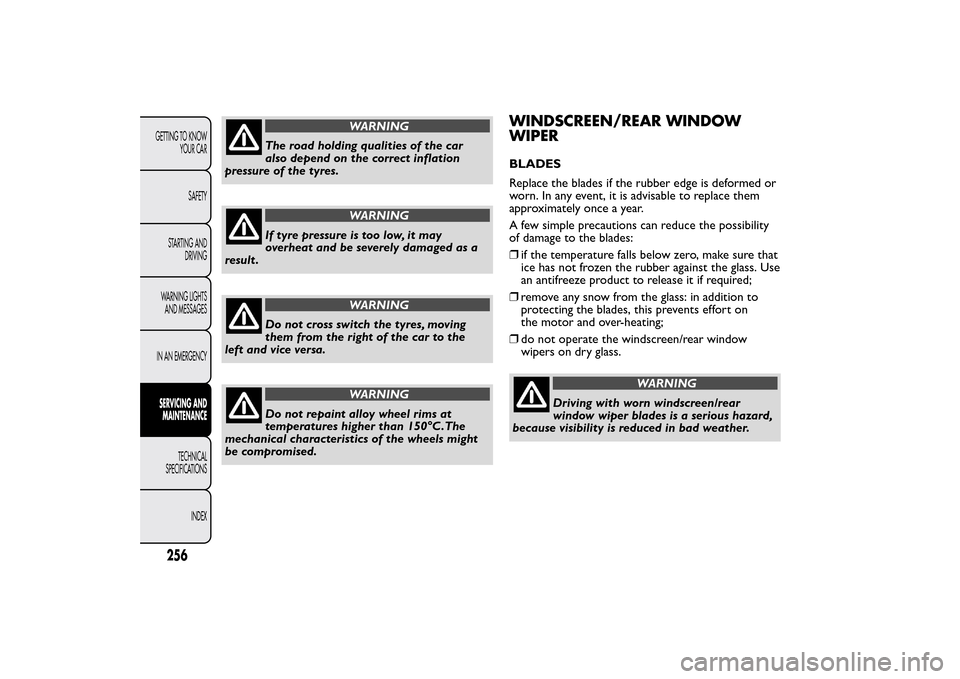
WARNING
The road holding qualities of the car
also depend on the correct inflation
pressure of the tyres.
WARNING
If tyre pressure is too low, it may
overheat and be severely damaged as a
result .
WARNING
Do not cross switch the tyres, moving
them from the right of the car to the
left and vice versa.
WARNING
Do not repaint alloy wheel rims at
temperatures higher than 150°C.The
mechanical characteristics of the wheels might
be compromised.
WINDSCREEN/REAR WINDOW
WIPERBLADES
Replace the blades if the rubber edge is deformed or
worn. In any event, it is advisable to replace them
approximately once a year.
A few simple precautions can reduce the possibility
of damage to the blades:
❒if the temperature falls below zero, make sure that
ice has not frozen the rubber against the glass. Use
an antifreeze product to release it if required;
❒remove any snow from the glass: in addition to
protecting the blades, this prevents effort on
the motor and over-heating;
❒do not operate the windscreen/rear window
wipers on dry glass.
WARNING
Driving with worn windscreen/rear
window wiper blades is a serious hazard,
because visibility is reduced in bad weather.
256GETTING TO KNOW
YOUR CAR
SAFETY
STARTING AND
DRIVING
WARNING LIGHTS
AND MESSAGES
IN AN EMERGENCYSERVICING AND
MAINTENANCE
TECHNICAL
SPECIFICATIONS
INDEX
Page 280 of 420
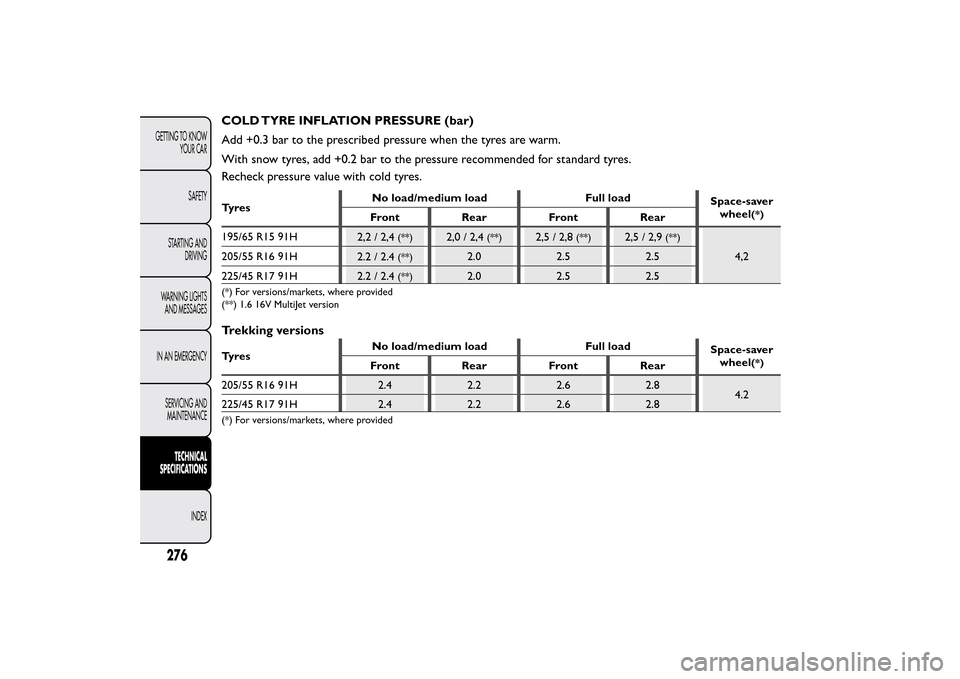
COLD TYRE INFLATION PRESSURE (bar)
Add +0.3 bar to the prescribed pressure when the tyres are warm.
With snow tyres, add +0.2 bar to the pressure recommended for standard tyres.
Recheck pressure value with cold tyres.Ty r e sNo load/medium load Full load
Space-saver
wheel
(*)
Front Rear Front Rear
195/65 R15 91H
2,2 / 2,4
(**)
2,0 / 2,4
(**)
2,5 / 2,8
(**)
2,5 / 2,9
(**)
4,2 205/55 R16 91H
2.2 / 2.4
(**)
2.0 2.5 2.5
225/45 R17 91H
2.2 / 2.4
(**)
2.0 2.5 2.5
(*) For versions/markets, where provided
(**) 1.6 16V MultiJet versionTrekking versionsTy r e sNo load/medium load Full load
Space-saver
wheel
(*)
Front Rear Front Rear
205/55 R16 91H 2.4 2.2 2.6 2.8
4.2
225/45 R17 91H 2.4 2.2 2.6 2.8
(*) For versions/markets, where provided
276GETTING TO KNOW
YOUR CAR
SAFETY
STARTING AND
DRIVING
WARNING LIGHTS
AND MESSAGES
IN AN EMERGENCY
SERVICING AND
MAINTENANCE
TECHNICAL
SPECIFICATIONS
INDEX
Page 322 of 420
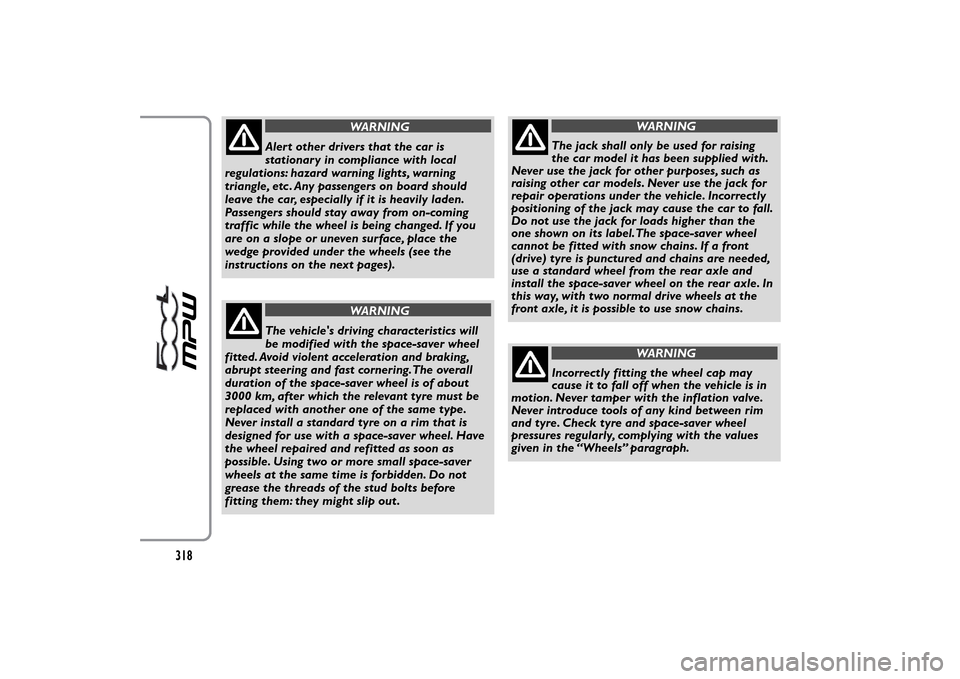
WARNING
Alert other drivers that the car is
stationary in compliance with local
regulations: hazard warning lights, warning
triangle, etc . Any passengers on board should
leave the car, especially if it is heavily laden.
Passengers should stay away from on-coming
traffic while the wheel is being changed. If you
are on a slope or uneven surface, place the
wedge provided under the wheels (see the
instructions on the next pages).
WARNING
The vehicle's driving characteristics will
be modified with the space-saver wheel
fitted. Avoid violent acceleration and braking,
abrupt steering and fast cornering.The overall
duration of the space-saver wheel is of about
3000 km, after which the relevant tyre must be
replaced with another one of the same type.
Never install a standard tyre on a rim that is
designed for use with a space-saver wheel. Have
the wheel repaired and refitted as soon as
possible. Using two or more small space-saver
wheels at the same time is forbidden. Do not
grease the threads of the stud bolts before
fitting them: they might slip out .
WARNING
The jack shall only be used for raising
the car model it has been supplied with.
Never use the jack for other purposes, such as
raising other car models. Never use the jack for
repair operations under the vehicle. Incorrectly
positioning of the jack may cause the car to fall.
Do not use the jack for loads higher than the
one shown on its label.The space-saver wheel
cannot be fitted with snow chains. If a front
(drive) tyre is punctured and chains are needed,
use a standard wheel from the rear axle and
install the space-saver wheel on the rear axle. In
this way, with two normal drive wheels at the
front axle, it is possible to use snow chains.
WARNING
Incorrectly fitting the wheel cap may
cause it to fall off when the vehicle is in
motion. Never tamper with the inflation valve.
Never introduce tools of any kind between rim
and tyre. Check tyre and space-saver wheel
pressures regularly, complying with the values
given in the “Wheels” paragraph.
318